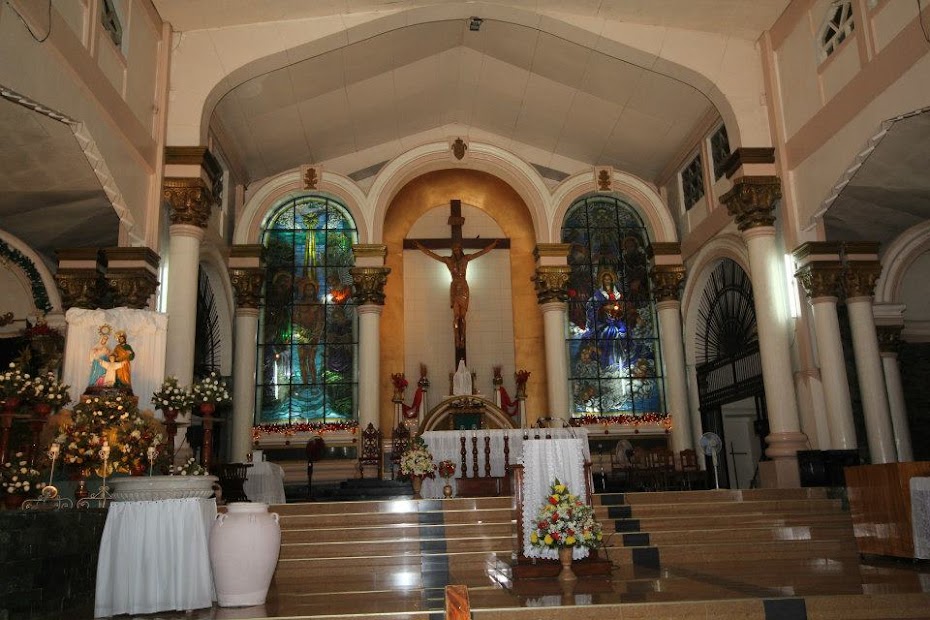It is not clear when the project was started, although it is known that on March 28, 1863 when Mons. Romualdo Jimeno Ballesteros, Bishop of Cebu, wrote the government authority in the Visayas regarding its establishment as an independent town and parish, he said that the church, together with the rectory, was almost finished. Oras became a parish on June 25, 1870 through a decree by the Bishop of Cebu, with Father Vicente Martinez as first parish priest, although it became an independent pueblo on December 13, 1849.
Dedicated to St Peter of Alcantara (San Pedro de Alcantara), whose feast falls on October 19, the parish church was made of cut coral stone and lime mortar masonry. Its size was 41’40 meters long, 13’20 meters wide, and its walls were 6’60 meters high. It had the form of the cross, much like the old churches of Borongan, Guiuan, Sulat and Tubig. It had three altars, with the altar mayor at the middle, and the two others were at the transept. In 1885, it still lacked sacristy and ceiling. Its few windows were high and small, since it served as refuge in case of Moro raids. The interior was, therefore, a bit dark, even during daytime.
Unfortunately, sometime in 1905, a group of Pulajanes under Cenecio Lazarra, its leader in the north, entered the town, killing almost everyone they met, and put to torch many houses, including the new church of stone. It was the biggest conflagration in the history of the town. It fell upon Father Felix Minaya, pastor from 1898 to 1906, to restore the burnt building. During the restoration, it acquired new images for its 3 altars. Above the altar mayor was the image of St Peter of Alcantara, with Juana Picardo as donor; the altar minor on the right wing had the image of St Anthony of Padua while the altar minor on the left wing had the image of St Francis of Assisi, donated by Juan Mengote.
When it became fashionable to discard the Spanish architecture in many parishes to adopt new ones, Oras was not spared. The plan to replace the church of stone with a church of concrete was conceived when Father Bernardo Baxal was parish priest (1953-1963). The demolition started in 1962 and was continued when Father Agripino Osal took over the parish. Designated to draw up the design of the new church was Fernando Batica, and contributions for the project poured in through family quotas and donations from parishioners. The posts, for instance, were sponsored by different families. The tiling of the center aisle was a gift from Atty Simaco Sacmar. It did not take long for the church to finish; by 1971, when Father Osal finished his term as parish priest, there was no longer any major improvements to be added.
The present church is 13.3 meters wide, 42 meters long and 8 meters high. In the 1981, Msgr Santos Paco, through Fernando Batica, constructed a two-storey building beside the church, at the west end of which rises a belfry that was blessed in 1985. He had the old bells displayed near the façade of the church. Having taken over the parish in 2001, Msgr Crescente Japzon introduced many improvements, including the concreting of the patio between the church and the rectory, installation of the main gate of iron grills to the rectory, construction of plant boxes for bantolinao, repairs of the sacristy and belfry, and redesigning of the grotto near the sacristy. A choir loft was added through the generosity of Lydia Agudo. In 2012-2013, under the administration of Father Romeo Solidon, the sanctuary was renovated, along with the roof and ceiling as well as the back wall of the church, with the help of Engr Ronald Norcio.
In 2017, during the term of Father Dan Gañas, Reynaldo Lomuntad and Vivian Atrejenio donated a new altar table, Anecita Sugalan and Jocelyn Hagad the ambo, and the family of Charriville Noroña Nebrija the lectern for commentator. In the same year, adjacent to the gospel side of the sanctuary, the Team Ministry constructed a "House of Saints," actually a spacious room that houses the images of saints for public veneration, to the tune of about P350K. From 2019 to 2020, Father Gañas extended the left side of the church by more than 4 meters at the cost of about P1.1M, and he plans to do the same on the right side this year and the next. Considering, however, that the Oct 19 fiesta is around the corner, he set up a structure, made of steel pipes and galvanized iron, to extend the right side by 4½ meters in order to accommodate the ever increasing number of churchgoers during fiestas. This last runs on a budget of about P200K.











